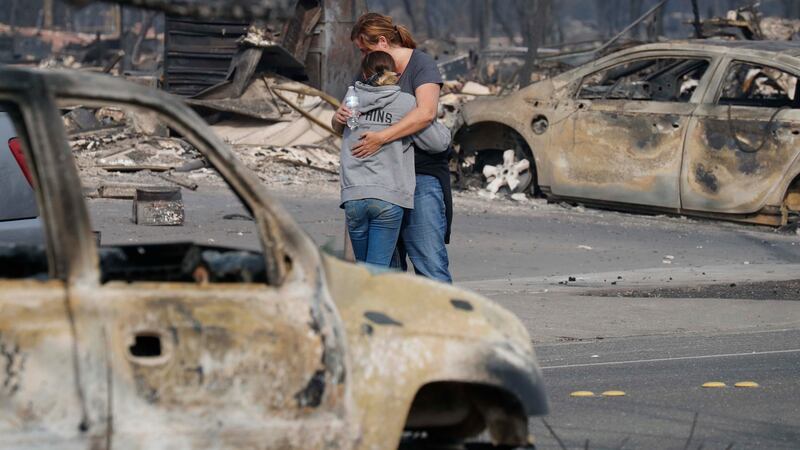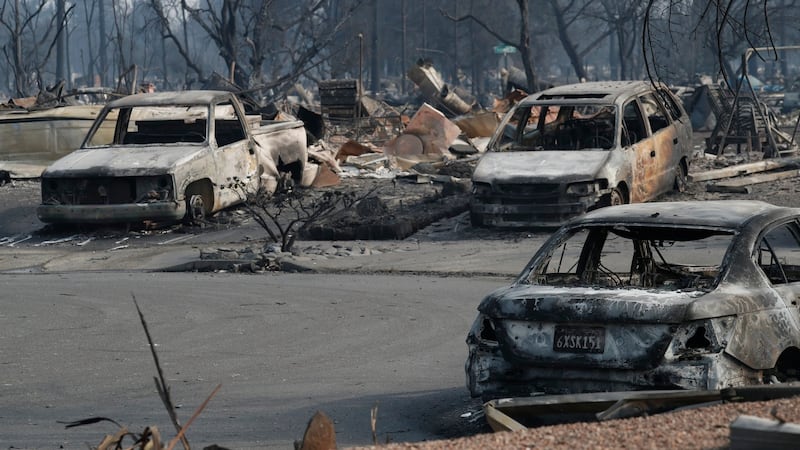Strong, dry winds may fan new wildfire outbreaks on Wednesday in California’s wine country, where blazes have killed at least 21 people and destroyed 3,500 homes and businesses, fire officials warned.
Gusts of up to 80kph and 10 per cent humidity are forecast for later on Wednesday and into Thursday for the region, where a dozen fires have forced 20,000 people to flee their homes in one of the deadliest wildfire outbreaks in California history, fire officials said.
“The potential for new fires that could grow exponentially as these fires did in such a short time period is there,” said Lynne Tolmachoff, spokeswoman for California Department of Forestry and Fire Protection.

The weather had given firefighters a reprieve on Tuesday as cooler temperatures, lower winds and coastal fog let them make headway against the fires that had burned more than 130,000 acres in Sonoma, Napa, Lake and Mendocino counties, north of San Francisco.
The Sonoma County Sheriff's Office said nine of the fatalities were in its jurisdiction, where 600 people were still missing, although 45 others had been found and some of those unaccounted for may be due to confusion surrounding evacuations.
Described as a “terrible tragedy” by Donald Trump, the president said the US federal government will “stand with the people of California”.
In Napa County, the dead included 100-year-old Charles Rippey and his wife Sarah Rippey (98) according to the county sheriff's office.
The couple first met at their elementary school in Wisconsin, close to 90 years ago. "They've basically been together ever since," said one of their sons, Mike Rippey. The couple died when a fast-moving wildfire whipped into their house and they were unable to escape.

No other details on that incident or the other fatalities were immediately available.
On Tuesday crews took advantage of cooler temperatures, lower winds and coastal fog to make headway against the fires but cautioned that homes, wineries and other structures remained at risk.
“We need to jump on it and take advantage of this lull before any other wind jumps up,” said Steve Crawford, a California Fire operations chief, at an afternoon briefing. “There’s a lot of devastation out there, people running around who just lost everything”.
Damage to vineyards
North of San Francisco, the fires reduced houses to ashes in several communities. The city of Santa Rosa was particularly hard hit by the so-called Tubbs Fire, which damaged a Hilton hotel and destroyed a mobile home park.
Tens of thousands of residents were forced to flee, as schools closed and at least two hospitals in Sonoma County were temporarily shuttered.
Napa Valley Vintners, a trade group with 550 members, said it was too early to estimate the economic impact of the fires. At least four wineries had suffered “total or very significant losses,” and at least nine others reported damage to their winery, outbuildings or surrounding vineyards, the group said.

Ninety per cent of grapes had been picked before the fires started, with almost all of those still on the vine Cabernet Savignon, a thick-skinned variety that is not expected to be impacted by smoke from the fires.
In addition to potential damage to vineyards from fire itself, sustained exposure to heavy smoke can taint unpicked grapes, according to wine-making experts.
More than 91,000 homes and businesses served by Pacific Gas & Electric were without power, with most of those customers in Northern California’s Sonoma and Napa counties, and gas was shut off to 28,000 customers, representatives for the utility company said.
California Governor Jerry Brown declared a state of emergency in Napa, Sonoma and five other counties.
In Southern California, the so-called Canyon Fire 2 has spread to 7,500 acres (3035 hectares) in Orange County, destroying 14 structures and damaging 22, fire spokesman Thanh Nguyen said.
The blaze triggered evacuation of 5,000 people in the communities of Anaheim Hills and Orange Hills as it spread through grass and oak trees, he said, and was only 25 per cent contained as of Tuesday afternoon.
Reuters , PA and New York Times
















